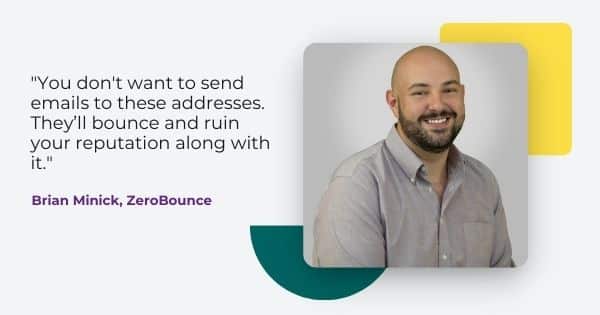
Disposable Emails and How to Handle Them in 2023
Updated on December 20, 2022
Disposable emails – you can find them in many email lists. How much do they impact your email deliverability, and how can you handle them? Our definitive guide will answer these concerns and show you how to detect temporary emails throughout 2023 proactively.
To help with this, we brought in a few email marketing leaders. Emily Ryan of Westfield Creative as well as Brian Minick and Vlad Stoian of ZeroBounce weigh in on the issues and provide you expert perspectives.
But first, let’s define the subject at hand.
What are disposable emails?
A disposable email is a temporary email address that automatically expires after a designated period.
Sometimes called “throwaway accounts” or “burner emails,” these addresses exist to be short-lived. They may work for as long as a few days or for as few as ten minutes. After the timer elapses, the account self-destructs and is no longer valid.
While the disposable email is active, the user can send and receive messages just like you can with a regular email address.
What are the types of temporary emails?
There are three primary categories of temporary accounts in place of their actual addresses.
Disposable/throwaway emails
Users obtain disposable emails via third-party sites or platforms. These tools can create a randomly-generated address that automatically deactivates after a certain amount of time. Once it expires, all future messages to throwaway address will bounce.
Aliases
Email service providers help users protect their privacy by allowing them to create an alias. This alternative version of their email collectors and stores messages in a different folder than their primary inbox. These can be tricky to deal with as they often show up in your campaign metrics as “delivered” but usually end up outside the target inbox with no way to measure the result.
Forwarding services
These services provide similar benefits to throwaway emails. However, when you send a message to the temporary address, the service redirects it to the user’s actual email address. The person can still manage content from their actual inbox but control their anonymity.
Why do people use disposable emails?
Internet privacy and spam are the primary motivators for using disposable email services.
Some individuals share their addresses freely. If they have an interest in a company’s news or promotions, they sign up for their email list. They may also use multiple email addresses, one for professional purposes and another for marketing materials.
Privacy skeptics are hesitant to give out their actual email addresses. If you’ve ever experienced an uptick in spam messages, someone likely bought or scraped your data somewhere online. It’s understandable why so many might rely on a disposable address when interacting with new websites.
For example, suppose your company is hosting a giveaway or promotion. This might feature a free audio download, a quality infographic or an e-book. These are popular marketing techniques, but they can also attract those that just want the free item.
Instead of signing up legitimately, they create a burner email, sign up, claim the freebie and leave. They come out with the free content, and you end up with an ingredient for bad email hygiene.
Finally, some may use temporary email addresses for nefarious purposes. They could be a competitor or a generally malicious person that wants to pollute your marketing efforts while remaining anonymous.
How do you get a disposable email?
The process of creating a temporary email is almost effortless. However, the process varies depending on the type of disposable address you wish to use.
You can visit websites like 10-Minute Mail or Temp Mail to create burner/throwaway accounts. You don’t need to provide your name, address, phone number or other identifying information. Because these services exist to preserve privacy, they’re effectively anonymous. They provide emails via random strings of letters or numbers. Sometimes, it’ll be two unusual words like “obsequiouscheetah.”
Most of these burner providers will only allow you to receive incoming mail. However, a few will also allow you to send email messages. You may also be able to keep the disposable email active longer by using it frequently or manually requesting more usage time.
To create an alias, look no further than your email service provider (ESP). Check out your ESP’s documentation to learn how to develop alternative addresses based on name variations, interests or roles.
Lastly, there are numerous email forwarding services available online. You generally need to create an account to connect your primary email and deactivate the service when you no longer need it.
The ease, dependability and reputation of these services vary, but they’re quick to set up. Some can generate a new email address without ever needing to leave the home page. After you set up and use the email it will quickly self-destruction. If you try to email the temporary address after that happens, it will bounce back. Repeated instances of this spells tragedy for your email reputation.
Disposable emails hurt your email marketing efforts
The everyday person might see a benefit from throwaway accounts, but they can quickly derail an email campaign.
Let’s look at what happens when you ignore who’s lurking on your email list(s).
Your emails will bounce
We spoke with an email campaigns specialist Emily Ryan of Westfield Creative. She advises:
“If you keep these emails on your list, they will end up bouncing. This shows services like Google or Yahoo that you’re not a valid sender… and therefore, you’ll land in Spam. Platforms like ZeroBounce have a monthly option that is really smart because it will ensure you keep your list clear of these disposable emails.”
Messages sent to to throwaway accounts are guaranteed bounces after they self-destruct. You believe you have a valid lead one day only to see your bounce rate increase the next.
Your email reputation suffers
Having an abundance of burners on your list is not a good sign for ESPs. If your bounce rate exceeds even 2%, email services will begin to take notice. If you’re regularly sending to invalid addresses, you appear unreliable. Someone untrustworthy is more likely to send spam.

Brian Minick, COO of ZeroBounce, explains what the dangers are:
“Disposable emails are one of the most detrimental forms of email addresses you can have on your list for a few reasons:
- The email will bounce after a very short period of time (10 minutes – 24 hours)
- You can never contact or re-target that person again for your marketing or sales funnel”
Brian goes on to tell us how temporary emails work:
“A disposable email address is the equivalent to a ‘burner’ phone but it has a $0 cost associated with it. Anyone can go to a website like 10minutemail.com and take out a disposable email address. The email will send/receive mail just like any other normal email box. So it can complete a two-step verification or double opt-in process, but soon after that, it’s gone.”
Our COO concludes:
“You don’t want to send emails to these addresses. They’ll bounce and ruin your reputation along with it.”
A lousy sender reputation will severely affect your inbox placement. Even the people who signed up with their legitimate address and want to hear from you may only receive your emails when your domain is considered trustworthy and reliable.
Temporary emails damage your bottom line
Every email address you acquire has a cost.
You spend ad revenue promoting your landing pages or sales funnels. It cost you further to create a free item or to provide a discount. What you get in exchange for all of this is a viable lead.
However, disposable emails seldom lead to prospects. A person that uses a temporary account doesn’t take your brand seriously enough to provide their actual data. Therefore, marketing-wise, there’s little potential of anything positive happening by interacting with someone that uses one.
Additionally, a rise in burner accounts may indicate that you already have an issue with your reputation. If people see your content and feel you’re illegitimate or a spammer, they will not opt-in with a real address. It’s necessary to use some form of disposable email detection to identify problems at the point of sign-up as well as issues with your overall email reputation.
Your ESP may suspend you
Just like you, email services have a responsibility to protect their reputation. If your bounce rate rises and your reputation declines, they have the ability to suspend your account.
Each service has its policies regarding acceptable bounce rates. While we advise staying below 2%, some providers may allow up to 5% before taking notice. The frequency and nature of your bounced emails may also be a determining factor.
If you violate these policies, you may receive a temporary ban along with a notice to correct the issue. However, excessive bounces and major reputation issues can lead to an indefinite suspension. So long as you can remedy the situation, you can generally expect an account reinstatement.
If it gets to that point, you may require the help of an email professional to get your reputation and email list hygiene in order. After making improvements and documenting your actions, you can submit the evidence to your ESP for further reviewal.

How do I stop people from using a temporary address?
Emily Ryan believes every marketer will inevitably reach people who want something for nothing.
“There’s not much we can do on the marketing side to validate right at the ‘gate’ if an email is valid or not. So everyone – regardless if it’s disposable or not – will get the freebie. WHY? Because most automations are set up to trigger when ANY email is added to our email list.”
Emily, who has vast email marketing experience and is a Mailchimp partner, goes on to explain:
“Even if you have reCAPTCHA enabled (i.e., ‘Pick the squares that are stoplights.’), if the email is an actual email, it’s going to pass this automated check. Automations simply cannot tell at this point if it’s someone’s disposable email.
Very unfortunate for marketers, because those email addresses really hurt our deliverability down the road. That’s why we always recommend an email validation service.”
There’s nothing you can do to control the actions of others online. However, by managing your reputation, delivering high-quality content and strengthening your security, you can give your audience the confidence it needs to provide real data.
Email validation helps with disposable email detection
So, how exactly does one mitigate the risk of these anonymous sign-ups?
Emily advises:
“Every marketer needs a process for validating their clients’ emails on a regular basis. That’s truly the only way to keep your list clean and healthy which is vital in making sure your emails keep being delivered to the inbox.”
If someone wants to take advantage of your promotion, they can. As Emily points out, it all boils down to email validation to protect your email lists, some of the most valuable assets for an email marketer.
Email validation tools serve as disposable email checkers and can alert you to any untrustworthy or harmful contacts on your email list(s). They utilize internal technologies to communicate with email servers and identify potential issues. This saves you the problem of trial-and-error, which would lead to all of the setbacks discussed earlier in this article.
These tools not only tell you the number of throwaway accounts you have but inform of you which contacts they are specifically. You can then scrub these contacts from your list. This protects your reputation and helps you remain in compliance with your ESP’s sender policies.

The ZeroBounce email validation API rejects throwaway accounts in real-time
Vlad Stoian, our deliverability specialist at ZeroBounce, brings his years of experience to help countless customers handle disposable emails. He brings up the fact that disposable email providers constantly adjust how they work.
“Identifying disposable email addresses can be tricky. If disposable email providers used the same patterns and resources for a long period of time, they’d eventually be known for what they are. So they always change the ways they provide disposable addresses.”
“However,” Vlad adds, “with the experience we’ve gained over the years, we continue to investigate and adapt the methods we employ to identify them, maintaining a track record we’re proud of.”
That’s where real-time email validation makes all the difference when protecting your email reputation.
ZeroBounce’s email validation API detects disposable email contacts on your list when you run it through the bulk email validator. But, what makes it better is that the API will block low-quality email addresses in real-time whenever a user attempts to provide one during sign-up. This helps you avoid bad data while delivering engaging email content.
You can use it for your paid ad campaigns, newsletter sign-ups or anywhere else you collect email leads. Rather than risk re-contaminating your lists with disposable addresses, you can automate disposable email detection for ongoing protection.
If you need help setting up your API, Vlad and the support team are available 24/7/365 to walk you through the process.
Use email validation to combat disposable emails
Throwaway accounts are ubiquitous, but taking a proactive approach to disposable email detection is the key to keeping your list in good shape.
Their existence is a reminder that you should always present yourself and your brand in a trustworthy manner. Additionally, you always want to offer consistent value through your email marketing efforts.
Not only will this organically keep temporary emails at bay, but it will also build healthy, long-term engagement with your target audience.
Frequently asked questions
A disposable email address, sometimes called a throwaway account, is an address that automatically expires after a set period. The user can receive inbound mail and may also be able to send messages depending on the service used. After the period elapses, the address self-destructs and is no longer valid.
The only way to block them is to use disposable email detection. Real-time email validation offers this by identifying harmful or suspicious emails at sign-up time. After the validator detects a burner account, it will reject and prevent it from entering your email list.
You can detect disposable email addresses by using email validation. An email validation tool will identify disposable email addresses, spam traps, catch-all, do not mail addresses and many others that negatively impact your email list hygiene.
People use disposable emails to protect their privacy and avoid spam. Many sites buy and sell email data, which makes some users reluctant to share their real email addresses. A temporary address allow them to sign up for offers or promotions without relinquishing their personal information. If your brand seems unreliable, people are more likely to use a disposable address.






